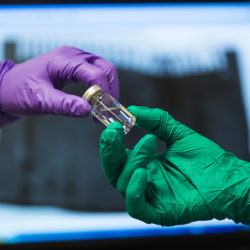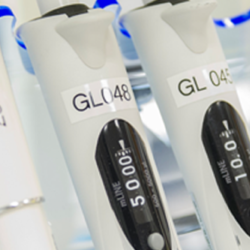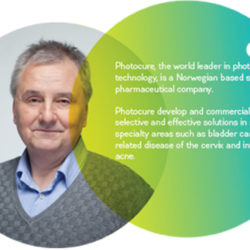Nordic Nanovector ASA – Results for the Third Quarter 2017
Nordic Nanovector is ready to initiate the pivotal Phase 2b study, PARADIGME, with Betalutin® in patients with relapsed, anti-CD 20 Ab-refractory FL (R/R FL), a high unmet medical need group, pending approval of the proposed trial design from regulatory authorities.
PARADIGME is designed to generate the clinical data needed to support the filing of the best Betalutin® dosage regimen for this patient population. The PARADIGME design is aligned with health authority and clinical expert feedback. The company is also enrolling patients into its Phase 1 study in DLBCL, and making final preparations to start a Phase 2 combination study of Betalutin® and rituximab in iNHL patients (ARCHER-1) in 2017. Preparations to initiate a Phase 1 study of Humalutin® are also progressing.
Luigi Costa, CEO of Nordic Nanovector, comments: “The company has made excellent progress during 2017. Clinical results with Betalutin® and in-depth market research confirm its potential to be an important treatment of patients with iNHL. We are on track to start the pivotal PARADIGME study, which aims to compare the two promising dosing regimens that have emerged from our ongoing clinical trial with Betalutin®. We are confident that the trial design will generate the robust data needed and improve the probability of a successful regulatory filing. We are also pleased with recruitment into our DLBCL study and with the preparations to start the ARCHER-1 study of Betalutin® in combination with rituximab, which is on track to begin soon.”
Operational Highlights Q3’17
• Steady progress towards planned start of the pivotal Phase 2b study PARADIGME in 2H 2017 to investigate Betalutin® in patients with 3rd line R/R FL
o PARADIGME expected to be a global, randomized Phase 2b trial comparing the two most promising dosing regimens identified from the LYMRIT-37-01 Phase 1/2 study in approximately 130 patients with R/R FL
o Objective to generate the clinical data needed to support the filing for market approval of the best Betalutin® dosage regimen
o Design builds on promising clinical results and is aligned with regulatory authority feedback
o Protocol amendment submitted and under review by multiple regulatory authorities with further submissions expected in the coming weeks; other preparations to initiate trial underway
o Patient screening anticipated to begin before end of 2017 (pending approval of the amendment)
• Recruitment of DLBCL patients into Phase 1 dose-escalation study with Betalutin® ongoing
o Patient recruitment on track in the US and Europe
• Preparations advancing for Phase 2 clinical trial to investigate the potential of Betalutin® combined with rituximab in 2nd line FL (ARCHER-1)
o Phase 2 trial planned to begin in 2H 2017
• Appointment of Dr. Reza Safaei as Head of Medical Affairs
o First field-based medical staff being recruited, to support patient enrolment into clinical trials in US and EU and to raise awareness of Nordic Nanovector’s technology
Financial Highlights Q3’17
(Figures in brackets = same period 2016 unless otherwise stated)
• Revenues for the third quarter amounted to NOK 0.1 million (NOK 0.1 million). Revenues for the first nine months of 2017 were NOK 0.3 million (NOK 0.2 million).
• Total operating expenses for the third quarter were NOK 72.7 million (NOK 50.4 million). Total operating expenses for the first nine months of 2017 amounted to NOK 214.9 million (NOK 151.3 million).
• Comprehensive loss for the third quarter amounted to NOK 85.9 million (loss of NOK 61.3 million). Comprehensive loss for the first nine months of 2017 was NOK 207.9 million (NOK 176.5 million).
• Cash and cash equivalents amounted to NOK 803.7 million at the end of September 2017 (NOK 881.4 million at 30 June 2017, NOK 933.3 million at 31 March 2017 and NOK 1 018.2 million at 31 December 2016).
Outlook
Nordic Nanovector aspires to become a leader in the field of Precision Therapies for haematological cancers by developing, manufacturing and commercialising innovative therapies to address major unmet medical needs and advance cancer care.
Betalutin®, the company’s most advanced product candidate, is developing a well differentiated, competitive, clinical profile for R/R FL, based on the promising preliminary results from the LYMRIT 37-01 Phase 1/2 clinical study. The company anticipates initiating its pivotal Phase 2b PARADIGME trial with Betalutin® in 3rd line R/R FL with the goal to have the data read-out and first submission for marketing approval in the second half of 2019. Management will continue to focus its efforts on the efficient execution of its plans and to meet clinical and pre-commercialisation milestones. The company is confident that Betalutin® could become an attractive and convenient therapeutic option, which, based on detailed market research, has the potential to be commercially successful.
Nordic Nanovector intends to maximize the value of Betalutin® across other stages of FL, NHL and other haematological cancer indications. A further element of the company’s strategy is to selectively extend its pipeline of novel targeted biopharmaceutical candidates to support future growth.
Current cash resources are expected to be sufficient until first regulatory filing of Betalutin® in 3L FL, based on the timely approval of the proposed new trial design, and to advance other key programmes.
About Nordic Nanovector:
Nordic Nanovector is committed to develop and deliver innovative therapies to patients to address major unmet medical needs and advance cancer care. The Company aspires to become a leader in the development of targeted therapies for haematological cancers. Nordic Nanovector’s lead clinical-stage candidate is Betalutin®, a novel CD37-targeting Antibody-Radionuclide-Conjugates (ARC) designed to advance the treatment of non-Hodgkin’s Lymphoma (NHL). NHL is an indication with substantial unmet medical need, representing a growing market forecast to be worth nearly USD 20 billion by 2024.
The Company aims to rapidly develop Betalutin®, alone and in combination with other therapies, for the treatment of major types of NHL, targeting first regulatory submission in relapsed/refractory follicular lymphoma in 2019.
Nordic Nanovector intends to retain marketing rights and to actively participate in the commercialisation of Betalutin® in core markets.
The Company is also advancing a pipeline of ARCs and other immunotherapies for multiple cancer indications.
Further information about the Company can be found at www.nordicnanovector.com
Source: Nordic Nanovector



